South Lancashire Tramways
History
The South Lancashire Tramways Company, along with the Lancashire Light Railways Company and the South Lancashire Electric Supply Company, was a subsidiary of the South Lancashire Electric Traction and Power Company Limited. The SLET&PCo had grand aspirations for a tramway network stretching from the Liverpool boundary in the west to Swinton and Worsley in the east, not to mention a rather wild scheme for a tramway connecting Bolton and Darwen, which would have traversed a rural landscape with no passengers worth speaking of.
The company also hoped to tap into what it saw as a potentially lucrative freight market, by moving goods at night between the South Lancashire cotton manufactories and Liverpool. To do this, it hoped to construct a connection between Liverpool Corporation Tramways and St Helens Corporation Tramways in the west, then eastwards from the latter, through towns such as Ashton-in-Makerfield, Platt Bridge, Hindley, Leigh, Atherton, Tyldesley and Swinton. The LLRCo was to build and operate the lines to the west of St Helens (known as the Liverpool and Prescot Light Railway), and the SLTCo, all the lines to the east. The company rather naively assumed that St Helens Corporation — which sat between the two planned systems — would play ball, as operation of that town's tramway system was leased to the New St Helens & District Tramways Company, which shared several directors with both the SLET&PCo and its subsidiaries. Unfortunately, the corporation were fundamentally opposed to the movement of goods over the tramway, so the company's grand design (and with it its business plan — in modern parlance) were compromised from Day 1.
The SLTCo eventually gained powers for 76 miles of standard gauge, overhead electric tramway, much of which was never built. Its first service — from Lowton to Four Lane Ends — commenced on the 20th October 1902, with further lines opening later that year and the following year. The company had however greatly over-reached itself financially, being forced into receivership in July 1904, along with its parent company and the LLRCo. The SLTCo was eventually rescued from receivership on the 2nd January 1906 by the newly formed Lancashire United Tramways, which was effectively a restructured company run by several of the old SLET&PCo directors. The LUT also went on, in October 1906, to acquire control of the NStH&DTCo, though this did not bring inter-running between the St Helens Corporation Tramways and the SLTCo any nearer; a short stretch of SLTCo track between Ashton-in-Makerfield and Haydock was however leased to the NStH&DTCo from October 1909, as it made more sense for the line to be wholly worked by that company.
The SLTCo steadily expanded, building new connecting lines and leasing others from smaller municipal authorities who had elected to construct their own tramway lines (e.g., Farnworth Urban District Council). At its maximum extent the SLTCo operated circa 39 miles of tramway, 32.50 miles owned by the company, 3.22 miles by Farnworth UDC, 1.98 miles by Kearsley UDC, 0.32 miles by Hindley UDC, and 1.4 miles by Barton-upon-Irwell Rural District Council. This made the SLTCo the largest non-municipal tramway operator in the UK, outside of London.
The system, with Atherton at its centre, comprised lines: westwards to Hindley then southwestwards to Platt Bridge, Ashton-in-Makerfield and Haydock; southwestwards to Leigh and Lowton St Marys; northwards to Four Lane Ends; and eastwards to Tyldesley, Boothstown, Worsley and Swinton, with a large loop embracing Walkden Farnworth, Kearsley, Clifton and Pendlebury.
The tracks of the SLTCo met those of St Helens Corporation (at Haydock), Wigan Corporation Tramways (at Hindley, Platt Bridge and Ashton-in-Makerfield), Bolton Corporation at Four Lane Ends and Moses Gate, and Salford Corporation Tramways at Swinton, Pendlebury and Worsley (over tracks owned by Eccles Corporation). Other than an early agreement with Bolton, meaningful through-running with other neighbouring systems only came very late in the day (the mid-to-late 1920s), with SLTCo tracks often stopping yards short of the municipally operated ones (WCT and SCT). This was certainly this was not for the want of trying, particularly on the part of the SCT, whose best efforts were continually frustrated by Eccles Corporation, from whom it leased the connecting lines. Nevertheless, through running or joint service agreements were eventually put in place, which saw SLTCo tramcars reach Bolton, St Helens, Salford and Manchester, and those of the SCT, SHCT and WTC run over SLTCo tracks.
Like many tramway systems, the SLT emerged from the Great War in a very run-down state, with a large backlog of maintenance work and postponed renewals. One positive however, was the number of passengers carried, which by 1919 was fully 85% higher than 1914. The 1st October 1919 saw a significant change for the LUT, with St Helens Corporation taking over operation of its system, the NStH&DTCo then being liquidated; as the Liverpool and Prescott Light Railway was operated by the NStH&DTCo, and the depot was in St Helens, the LLRCo was duly sold to Liverpool Corporation Tramways on the same day.
Whilst the SLTCo focused on tram operation, the LUT now concentrated its energies on the bus side of the business; although it had experimented with bus operation — unsuccessfully — as early as the 23rd March 1906, it now plunged into the private hire and excursion business. It was however not to be long before the first bus service was introduced — 18th June 1920 — and this was followed by rapid expansion, helped by a spirit of cooperation between the company, the various local authorities and Ribble Motor Services. This also helped the SLTCo, as the parent company avoided competing with the tramways lines, and where this could not be avoided, higher fares were charged.
The success of the LUT's bus operation led to a change of name in 1928 to the Lancashire United Transport and Power Company. Despite some investment in track and cars, as well as the construction of long hoped for connections to neighbouring tramway systems (to the SLT at Swinton [in 1926] and Pendlebury [in 1928], and to WCT at Ashton [1927]), the SLTCo was now faced with major track renewals. Some of these were on poorly used routes, whilst others with heavier usage could not be doubled due to the narrowness of the streets. As a result, the company obtained powers in 1929 to abandon the tramways and to operate trolleybuses in their place. The decision to opt for trolleybuses rather than buses was no doubt influenced by the fact that the company was an electricity generator. The name of the company was duly changed — on the 29th May 1929 — to South Lancashire Transport.
Other than the very short Bag Lane route, on which regular tram services may have been withdrawn as early as the Great War (this is unclear), the first route to be converted was Atherton to Ashton, the last tram running on the 2nd August 1930. The rest of the routes followed in quick succession, the last SLTCo tram running on the 16th December 1933. The SLTCo however, remained a tramway owner, as both Bolton and Salford Corporations still operated services over SLTCo-owned tracks. The last of these services — operated by BCT — was withdrawn on the 12th November 1944.
The SLTCo was always hamstrung by the relatively undeveloped landscape through which it ran (between the towns), whereas trams are first and foremost a prime mover of large numbers of people in an urban setting. Operation was not helped by long stretches of single lines with loops, nor by having to meet the needs of the various local authorities through whose areas it ran, many of whom extracted onerous concessions from the company. The undoubted potential of through-running with neighbouring authorities was only partially realised, largely due to the intransigence of a handful of councils. It is therefore unsurprising that the SLTCo struggled, taking until 1919 to pay its first dividend on ordinary shares.
Uniforms
Tramcar crews were initially issued with double-breasted, 'lancer-style' tunics with two rows of five buttons — narrowing from top to bottom — bearing the company title and a monogram of intertwined system initials (see link); the tunics had upright collars and epaulettes. Although the conductor in the 1902 photo below is wearing a tunic with plain collars (i.e., without insignia), photos taken not long afterwards clearly show that the right-hand collars bore individual systems initials, 'S L T'. The epaulettes also carried insignia of some description, though exactly what remains unclear. Caps were in a kepi style with a stiff glossy peak; they carried standard, 'off-the-shelf', script-lettering grade badges, either Driver or Conductor, though occasionally Motorman also made an appearance. These badges were almost certainly issued in brass, though a change may have been made to nickel in later years.
The kepi-style caps were superseded around 1904/5 by soft-topped military-style caps, which were in turn superseded by caps with tensioned crowns (tops), possibly as early as 1906, but certainly by 1908. The caps continued to carry script-lettering grade badges, but with Guard replacing Conductor at some point. The term 'Guard' was a designation used by a handful of systems nationally, but only Manchester Corporation Tramways, along with Stalybridge, Hyde, Mossley and Dunkinfield Tramways, actually issued badges to match, and then only as collar badges. Occasional photographs also suggest that a small round badge may have been worn above the script-lettering cap badges by some individuals, though this is far from clear.
At some point in the 1920s, a switch was made to single-breasted jackets, but for conductors only; these had five buttons, two breast pockets (with button closures), epaulettes and upright collars; the latter appear to have borne 'S L T' initials, but on the right-hand side only. In the twilight years of the system, around 1929/30, both motormen and conductors began to be issued with more modern single-breasted jackets with four pockets, lapels and epaulettes; the latter appear to have carried insignia of some description, possibly an employee number, though confirmation must await the discovery of more reliable photographic evidence.
Staff were also issued with double-breasted greatcoats with high fold-over collars; no insignia, other than the buttons, were carried on these garments.
A single studio portrait of an SLT inspector has survived, which shows that in the early years of the system, they wore double-breasted jackets with two rows of five buttons, the top set buttoning through the lapels; the upper part of the latter (the collars) bore embroidered system initials — 'S L T' — on both sides. The jacket also bore braided epaulettes. Caps were in a military style with a tensioned crown (top); they were embellished with braiding and bore the grade — Inspector — in embroidered script lettering. It is currently unclear what uniform was worn in later years.
Female conductors (which the SLT, like nearby Manchester, referred to as 'female guards') were employed during the Great War (from late 1915) to replace male staff lost to the armed forces. These ladies were issued with long skirts and long, tailored, double-breasted jackets with lapels and epaulettes. Headwear took the form of large bonnets, which probably, though not certainly, bore a script-lettering grade badge.
Further reading
For a history of the system, see: The South Lancashire Tramways Company Ltd' by E K Stretch, revised by Ted Gray; Triangle Publishing (2006).
Images
Motormen and conductors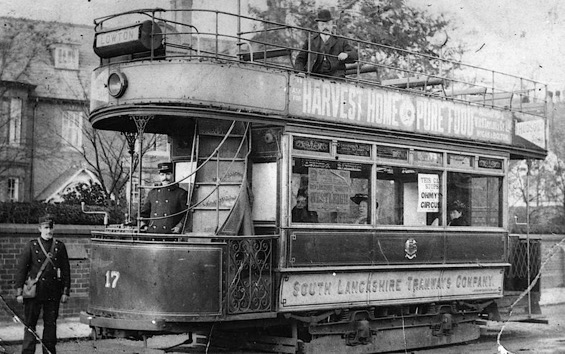
The crew of Tramcar No 17 stand with their charge at Pennington in 1902 — photographer, T Boothroyd. Photo courtesy of Ted Gray.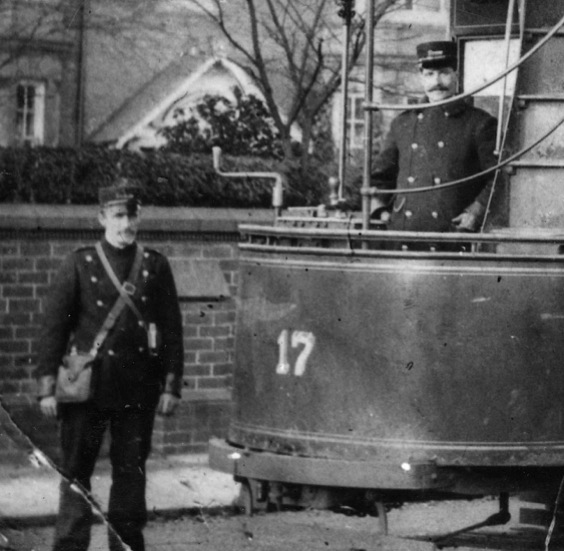
A blow-up of the above photo showing the conductor and motorman. Both men are wearing kepi-style caps with standard, 'off the shelf', script lettering grade badges: Conductor and Driver. The conductor is wearing a 'lancer-style' tunic with upright collars (left plain) and epaulettes, the latter possibly carrying insignia of some description. Photo courtesy of Ted Gray.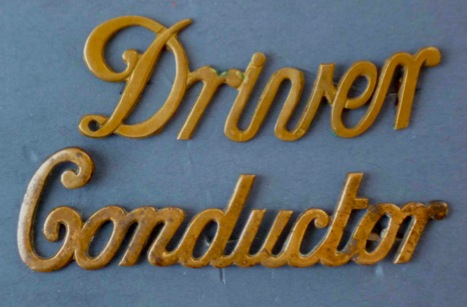
General pattern script-lettering cap badges of the type used by the South Lancashire Tramways Company — brass. Author's Collection.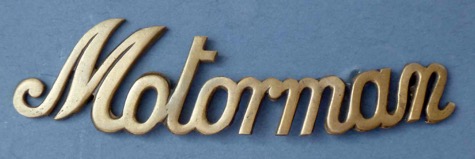
General pattern script-lettering Motorman cap badge, seemingly issued sporadically to South Lancashire Tramways drivers in the early years of operation — brass. Author's Collection.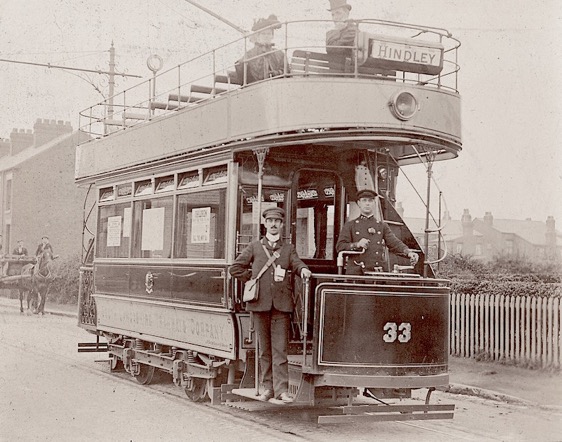
A very smart looking Tramcar No 33 with a service bound for Hindley — although undated, the photo must have been taken no later than 1906 when the tram livery changed, and very possibly in 1904 given the excellent condition of the tram. Photo courtesy of Ted Gray.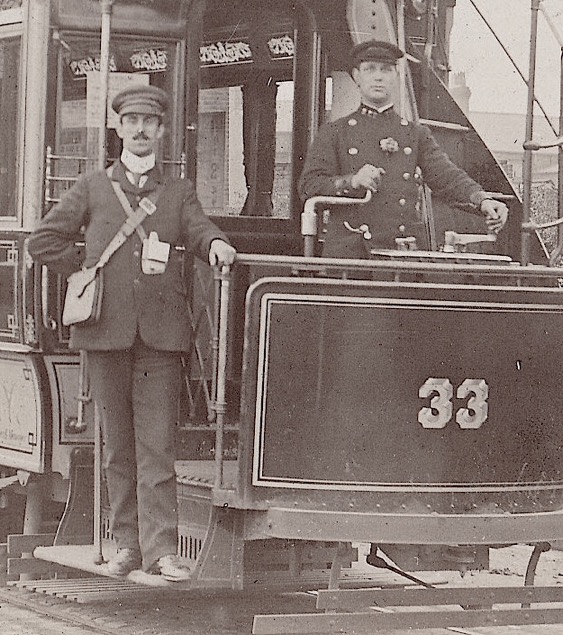
A blow-up of the above photo, which reveals that both men are wearing soft-topped caps rather than kepis. The motorman clearly has 'S L T' initials on his right-hand collar, as well as unidentified insignia on the left-hand side. The conductor would appear to be wearing informal attire, possibly awaiting the delivery of his uniform.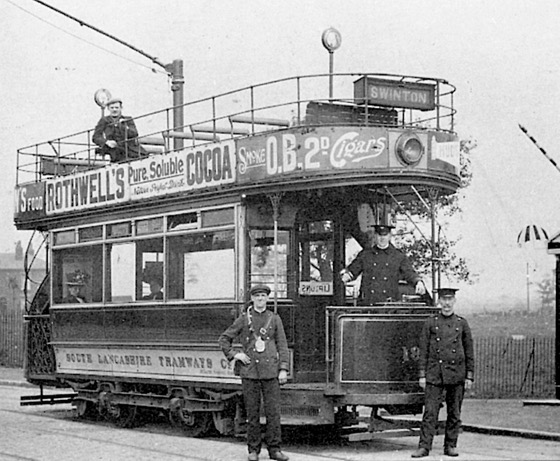
Tramcar No 19 stands at Mosley Common around 1908. Although the conductor is wearing a flat cap, the other two individuals, both of them probably motormen, are wearing military-style caps with tensioned crowns, confirming that these caps must have been introduced in the mid-Edwardian era. Photo courtesy of the Tramways and Light Railway Society, with thanks to David Voice.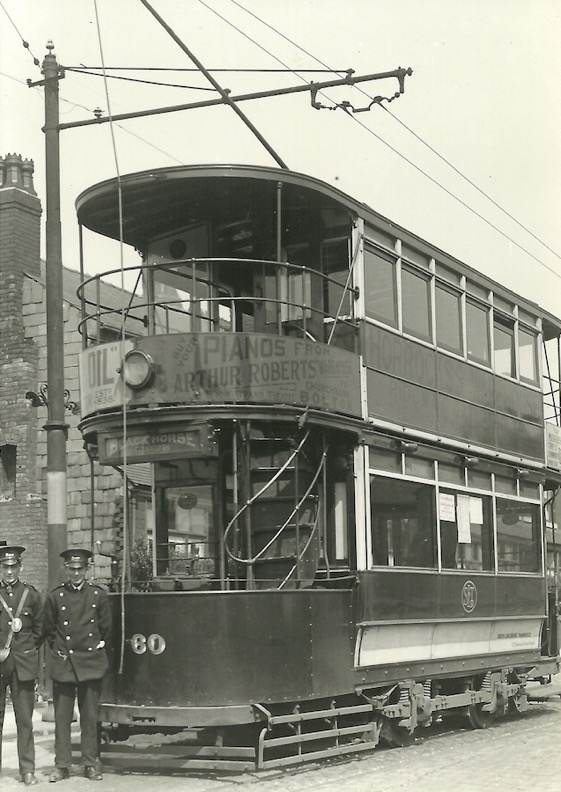
The crew of Tramcar No 60 — bound for Black Horse — pose for the cameraman in Swinton on 19th July 1929. Photo by Dr H Nicol, courtesy of the Stephen Howarth Collection.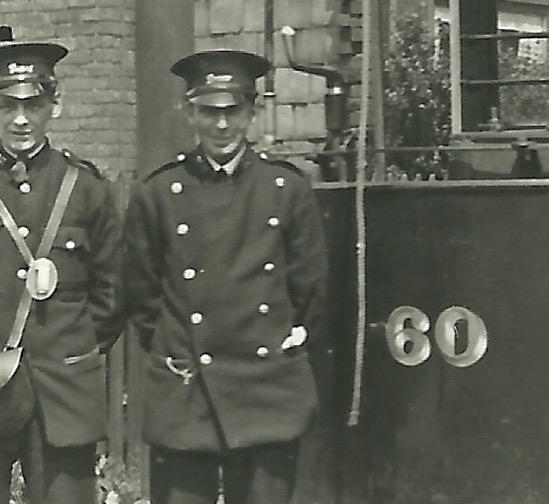
A blow-up of the above photo showing the conductor (in single-breasted jacket) and motorman (in double-breasted, 'lancer-style' tunic). The 'S L T' collar initials, worn on the right-hand side only, can just be made out. Whilst the motorman's cap badge is clearly Driver, the conductor's is very probably Guard.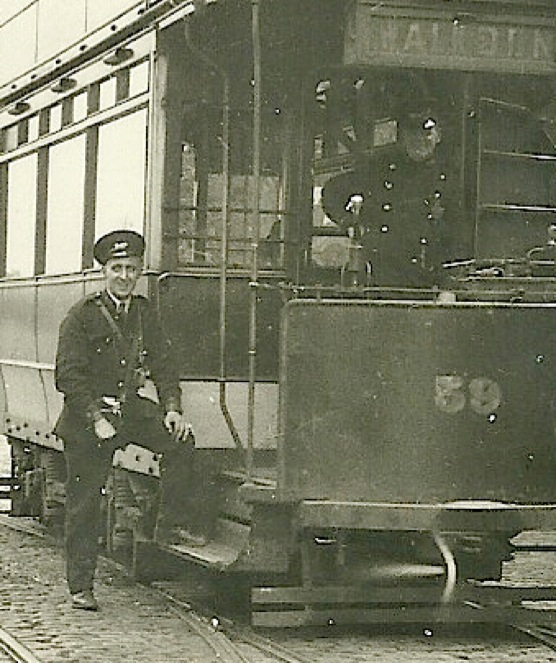
A conductor and motorman pose for the cameraman at Swinton Church in 1931 with Tramcar No 59. The conductor ('Guard' in SLT parlance) is wearing a modern single-breasted jacket with lapels and epaulettes. Stephen Howarth Collection.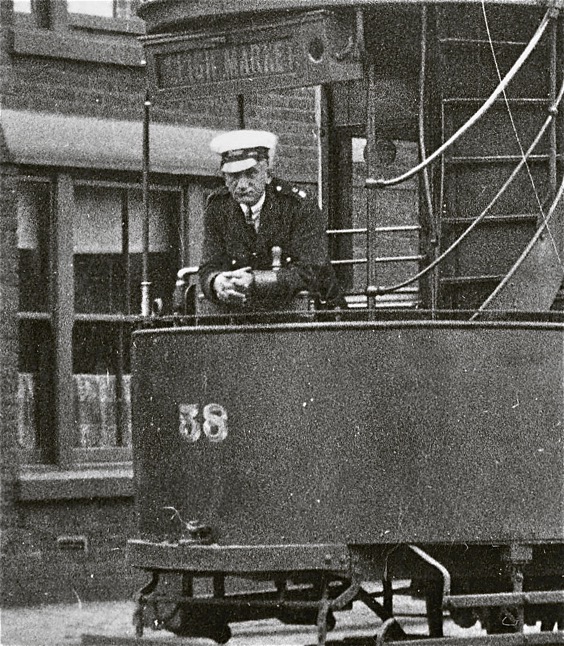
A motorman at the controls of Tramcar No 58 at Four Lane Ends on 13th August 1933. He is wearing a single-breasted jacket with lapels and epaulettes, the latter carrying insignia of some kind, possibly an employee number. Photograph by M J O'Connor.
Senior staff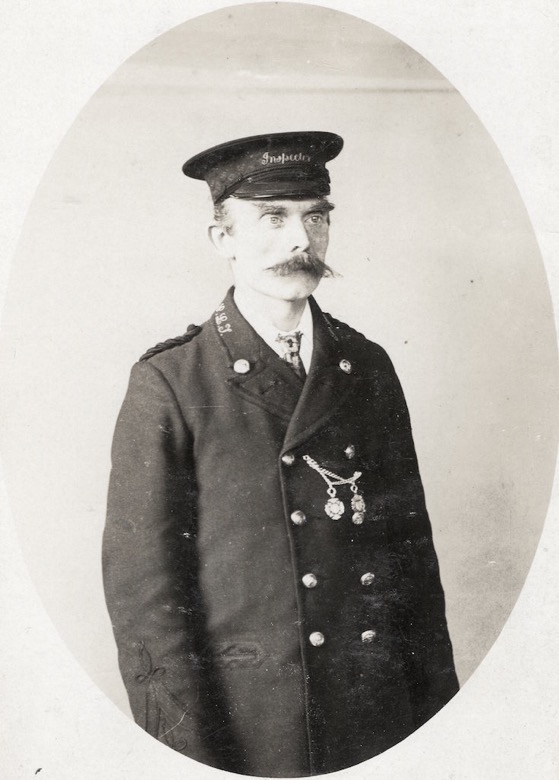
A rare studio portrait of a South Lancashire Tramways inspector — photo undated, but almost certainly early Edwardian. The back of the photo bears the inscription 'Uncle Herbert, Dad's brother'. Author's Collection.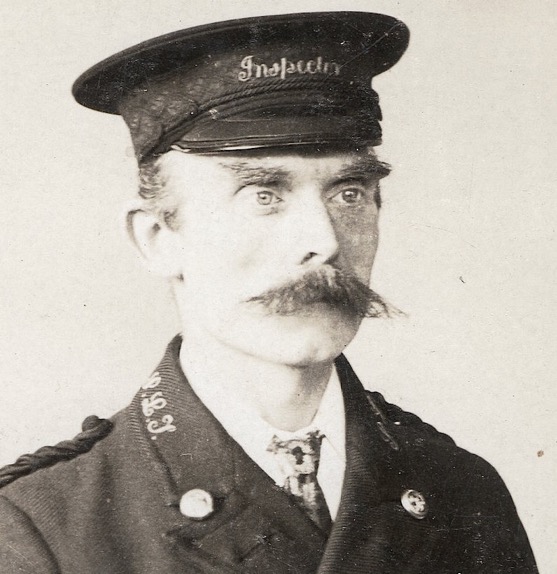
A blow-up of the above photo showing details of the uniform and cap.
Female staff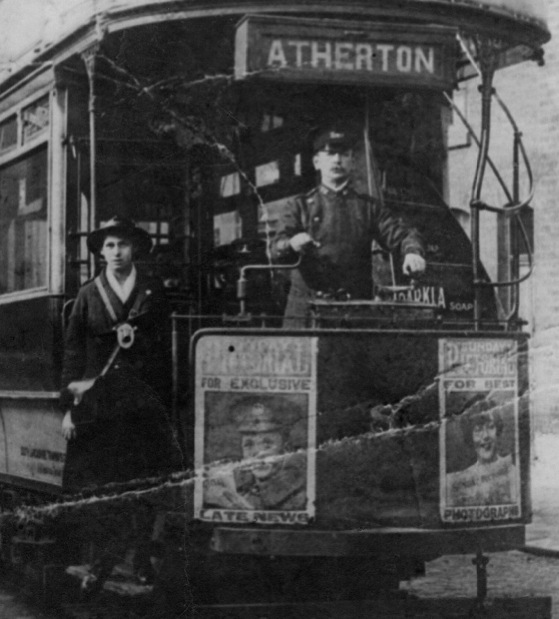
A conductress and a motorman pose aboard Tramcar No 8 at Ashton-in-Makerfield with a service bound for Atherton — photo dated 1917. Author's Collection.